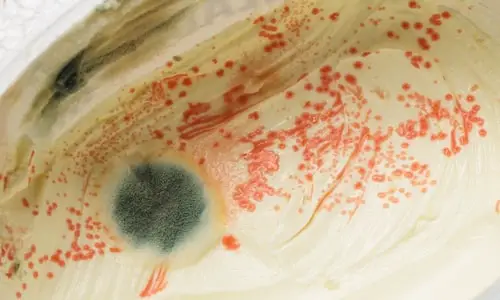There’s not much worse than going to your refrigerator and picking out your cream cheese to make your favorite dessert, only to find it covered with what looks like a thick layer of moldy growths.
What are you to do in this situation? Can the rest of the cheese still be eaten if you scrape off the mold , is the moldy cream cheese dangerous, and how can you stop this from happening again?
, is the moldy cream cheese dangerous, and how can you stop this from happening again?
In this article, I will be answering all these questions and more, so for all you need to know about mold on cream cheese, keep reading.

What is cream cheese?
Cream cheese is a soft cheese made from unskimmed cow’s milk. Because cream cheese is made using cream from milk, it has a high-fat level, although lower-fat versions are available. In order to be called “cream cheese”, it must have a minimum fat content of 33% in the US, and 45-65% in the U.K.
Why do cream cheeses grow mold?
Cream cheese has a much higher water content than hard cheeses such as cheddar or Parmesan, this water can be utilized by mold and bacteria as a source of hydration.
The high fat and mineral content of cream cheese provides mold with exactly the kind of nutrition it needs to thrive. As it grows, the mold releases enzymes that break down macro and micronutrients in order for them to be absorbed. Combine these factors with improper storage temperatures and you have a recipe for moldy cheese.
Many kinds of cheese were created with the intention of having a long shelf life, so salts were added to draw moisture out and make the environment less hospitable for mold and bacteria, whereas cream cheese is a post-refrigeration creation, so these preservatives are not added, allowing them to spoil faster than harder cheeses and therefore, are more inviting to mold and bacteria.
How to tell if your cream cheese has gone bad
There are several methods you can use to tell if your cream cheese has become bad and may grow moldy, including using your sense of taste, smell, and vision.
Taste
Before you see any visible signs of moldy cheese, you may notice that your cream cheese has started to turn ever so slightly sour in taste. This is a sign that it is turning rancid, which is when the fat in the cream cheese begins to oxidize and break down. It is at the rancidity stage that mold and bacteria growth begin to increase.
You may also notice a change in texture once rancidity has set in, such as a lumpy or granular texture, instead of the smooth texture you would expect.
Smell
Along with a sour taste and odd texture, cream cheese will begin to change in its odor. For example, mild cheeses (such as cream cheese), will begin to smell more like strong blue cheese. Once it has begun to turn moldy, a musty scent would also be evident. This would be familiar to most people, as it is often compared to that of an old basement or attic.
Vision
Finally, the most obvious sign of moldy cheese is being able to see patches of growth on the top layer of cream cheese. Many forms of mold will begin as small patches of white, powdery, or velvet-like growth that spreads over time and may change color depending on the strain that is growing.
What types of fungi grow on cream cheese?
Penicillium mold is the most common strain of cream cheese mold. This is a very common mold that often grows on fresh fruits and vegetables, decaying wood, in soil, and on some dry cereals.
Cross-contamination is the most likely cause of penicillium mold growing within cream cheese, as the spores can become airborne and settle on the cheese once it has been opened. There is also a possibility of the milk the cheese is made from becoming contaminated, however, the pasteurization process usually kills most mold and bacteria.
Penicillium can be identified as white, cotton-like growths that grow in size and can change from white to blue even olive green over time.
What is the pink stuff?
Pink growth on cream cheese is unlikely to be mold, it is more probable that it is a result of lactic acids deliberately added to milk, reacting with other components.
This discoloration (called pinking), will cause no harm if consumed, but it is usually described by cheese mongers as a defect, and the product is often discarded if noticed during the process of caseiculture (cheese making).
The only exception to this rule is if it forms as a growth with a grainy texture. If this is the case, you could be dealing with a strain of bacteria called Serratia marcescens. In this instance, the cheese should be thrown away, as ingesting this bacteria can cause food poisoning.
What is the orange stuff on my cream cheese?
Orange mold is a rare occurrence on cream cheese, but it can happen. The strain of fungi most likely to grow with an orange hue on food items is called Sporendonema casei.
The good news is that this strain is harmless to humans and will not cause any symptoms in healthy individuals. However, people with allergies or suppressed immune systems should still be cautious, as inhalation or ingestion could still potentially cause allergic reactions or symptoms.
Can you get sick from eating it?
In the majority of cases, eating a small amount of cream cheese that was moldy is unlikely to cause much harm.
If you have allergies or a suppressed immune system, you may see symptoms developing after accidentally ingesting fungi, but this is rare and can occur when eating any moldy food.
However, mold and bacteria will tend to grow on cream cheese that has reached at least 40 degrees Fahrenheit for two hours or longer, and as much as a small amount of fungi may not cause harm, E. coli bacteria certainly can.
Even consuming small amounts of E. coli bacteria can lead to food poisoning, which is unpleasant for most, and potentially very serious for some.
It is for these reasons that you should never attempt to eat cheese that you suspect may be growing moldy or that has been left out at room temperature for more than 2 hours. If you think your cream cheese may have been left out of the refrigerator for some time, it is best not to take the risk, and discard it.
Can you cut off the mold from cream cheese and eat the rest?
No, if you cut off moldy growths and attempt to consume the rest is not recommended. When fungi form, it forms roots (known as threads), which burrow down into the deeper layers of the cream cheese and can spread mycotoxins throughout.
There is also the risk that during your attempt to cut away the moldy parts, you could disturb it, which would cause it to release its spores. These spores may then spread over the remainder of the cream cheese and set up new colonies.
In either case, there is a very high chance that you could end up eating moldy cheese, even if you removed the visible parts.
The additional factor here is that as fungi grow more readily on cream cheese that has become rancid (or is in the early stages of rancidity), it would also become very unpleasant to eat, so there would be little to gain from this process.
How to keep cream cheese from molding
The good news is, there are plenty of methods you can use to prevent mold and bacteria growth on cream cheese that will increase its shelf life considerably.
With that being said, use the following tips to store cheese to prevent it from becoming rancid and growing moldy.
Avoid cross-contamination
Whenever you are using cream cheese, ensure you do not “double-dip” by using the same utensil for multiple tasks. Doing so can introduce mold and bacteria into the container the cream cheese is being stored in.
Cover it in aluminum
To preserve leftover cream cheese, remove it from the container it was purchased in and place it in a tub or mason jar, then cover it with aluminum foil and wrap an electric band around it to keep it tight.
This method of storage allows it to breathe without it drying it out, prevents cross-contamination, and stops the cream cheese from absorbing flavors from other foods in the fridge.
Store it at the bottom of the fridge towards the back
The back and bottom of the fridge are affected the least by temperature fluctuations from the fridge door being opened, and as warm air rises to the top, the bottom of the fridge stays the most consistent in temperature.
This part of the fridge also has the lowest humidity, so keeping your cream cheese here will prevent excess moisture buildup, making it less hospitable for mold and bacteria.
Check the use-by date
As cream cheese lacks preservatives, it has a much shorter shelf life than other types of cheese, and so can grow moldy faster. When purchasing, ensure that you will be able to use the entire tub within its use-by date. You can often use a product for several days after its use-by date without it being dangerous, but it will certainly be well past its best.
Freeze it
As a final resort, if you have bought more cream cheese than you can use within its use-by date, you do have the option of freezing it. Freezing will put any spores and bacteria into a state of hibernation, preventing any further growth.
Cream cheese can be frozen for up to two months before it begins to deteriorate. There may be a small change in the texture and taste, but it still works very well in sauces and other baked goods.
When should you throw out moldy cream cheese?
As soon as cream cheese has been left out of a refrigerator for more than two hours, it should be thrown away. If you happen to also notice any signs of visible mold growth, the entire container should be discarded as there is no way to safely use it.
Why does cream cheese go moldy in the fridge?
You may think that as your cream cheese has been stored in the refrigerator at a low temperature, it shouldn’t be getting moldy as quickly as it seems to.
The penicillium mold that is likely growing in your cream cheese can grow at very low temperatures, lower than many other strains. This mixed with any increases in temperature, excess moisture, and potential cross-contamination can rapidly increase the rate at which mold grows, even whilst refrigerated.
Conclusion
Cream cheese has a high water content which allows mold and bacteria to grow much more easily than other types. Penicillium is the most likely to grow, and this can have the potential to be hazardous to humans with allergies or suppressed immune systems. To prevent mold growth, store any unused cream cheese in a container wrapped in aluminum at the bottom of the fridge towards the back.

